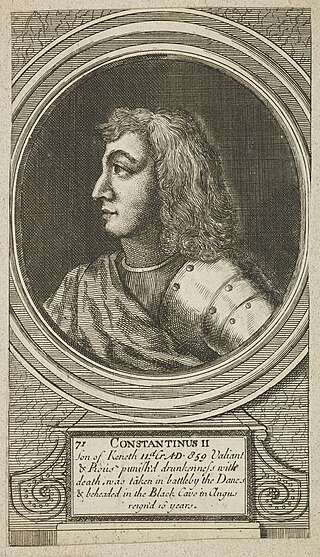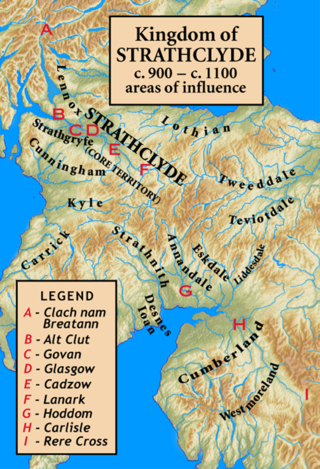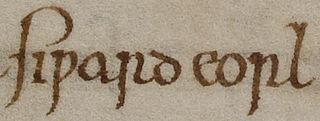Related Research Articles

Causantín mac Cináeda was a king of the Picts. He is often known as Constantine I in reference to his place in modern lists of Scottish monarchs, but contemporary sources described Causantín only as a Pictish king. A son of Cináed mac Ailpín, he succeeded his uncle Domnall mac Ailpín as Pictish king following the latter's death on 13 April 862. It is likely that Causantín's reign witnessed increased activity by Vikings, based in Ireland, Northumbria and northern Britain. He died fighting one such invasion.

Causantín mac Áeda was an early King of Scotland, known then by the Gaelic name Alba. The Kingdom of Alba, a name which first appears in Constantine's lifetime, was situated in modern-day Northern Scotland.

Æthelflæd, Lady of the Mercians ruled Mercia in the English Midlands from 911 until her death. She was the eldest daughter of Alfred the Great, king of the Anglo-Saxon kingdom of Wessex, and his wife Ealhswith.

Strathclyde was a Brittonic kingdom in northern Britain during the Middle Ages. It comprised parts of what is now southern Scotland and North West England, a region the Welsh tribes referred to as Yr Hen Ogledd. At its greatest extent in the 10th century, it stretched from Loch Lomond to the River Eamont at Penrith. Strathclyde seems to have been annexed by the Goidelic-speaking Kingdom of Alba in the 11th century, becoming part of the emerging Kingdom of Scotland.
Olaf Guthfrithson or Anlaf Guthfrithson was a Hiberno-Scandinavian (Irish-Viking) leader who ruled Dublin and Viking Northumbria in the 10th century. He was the son of Gofraid ua Ímair and great-grandson of Ímar, making him one of the Uí Ímair. Olaf succeeded his father as King of Dublin in 934 and succeeded in establishing dominance over the Vikings of Limerick when he captured their king, Amlaíb Cenncairech, in 937. That same year he allied with Constantine II of Scotland in an attempt to reclaim the Kingdom of Northumbria which his father had ruled briefly in 927. The forces of Olaf and Constantine were defeated by the English led by Æthelstan at the Battle of Brunanburh in 937.

Amlaíb mac Sitric, commonly called Amlaíb Cuarán, was a 10th-century Norse-Gael who was King of Northumbria and Dublin. His byname, cuarán, is usually translated as "sandal". His name appears in a variety of anglicized forms, including Olaf Cuaran, Anlaf Sihtricson and Olaf Sihtricson, particularly in relation to his short-lived rule in York. He was the last of the Uí Ímair to play a major part in the politics of the British Isles.

Scandinavian York or Viking York is a term used by historians for what is now Yorkshire during the period of Scandinavian domination from late 9th century until it was annexed and integrated into England after the Norman Conquest; in particular, it is used to refer to York, the city controlled by these kings and earls. The Kingdom of Jórvíc was closely associated with the much longer-lived Kingdom of Dublin throughout this period.

Siward or Sigurd was an important earl of 11th-century northern England. The Old Norse nickname Digri and its Latin translation Grossus are given to him by near-contemporary texts. It is possible Siward may have been of Scandinavian or Anglo-Scandinavian origin, perhaps a relative of Earl Ulf, although this is speculative. He emerged as a regional strongman in England during the reign of Cnut. Cnut was a Scandinavian ruler who conquered most of England in the 1010s, and Siward was one of many Scandinavians who came to England in the aftermath, rising to become sub-ruler of most of northern England. From 1033 at the latest, he was in control of southern Northumbria, present-day Yorkshire, governing as earl on Cnut's behalf.
Eadwulf or Eadulf was ruler of Bamburgh in the early tenth century. A genealogy in the twelfth-century text De Northumbria post Britannos recording the ancestry of Waltheof Earl of Northampton, makes Eadwulf the son of Æthelthryth daughter of Ælla, King of Northumbria, but no source names Eadwulf's own father.
Ealdred was a ruler of Bamburgh, at least part of the former kingdom of Bernicia in northern Northumbria, in the early tenth century. He was the son of Eadwulf.
Sitric Cáech or Sihtric Cáech or Sigtrygg Gále, was a Hiberno-Scandinavian Viking leader who ruled Dublin and then Viking Northumbria in the early 10th century. He was a grandson of Ímar and a member of the Uí Ímair. Sitric was most probably among those Vikings expelled from Dublin in 902, whereafter he may have ruled territory in the eastern Danelaw in England. In 917, he and his kinsman Ragnall ua Ímair sailed separate fleets to Ireland where they won several battles against local kings. Sitric successfully recaptured Dublin and established himself as king, while Ragnall returned to England to become King of Northumbria. In 919, Sitric won a victory at the Battle of Islandbridge over a coalition of local Irish kings who aimed to expel the Uí Ímair from Ireland. Six Irish kings were killed in the battle, including Niall Glúndub, overking of the Northern Uí Néill and High King of Ireland.
Owain ap Dyfnwal was an early tenth-century King of Strathclyde. He was probably a son of Dyfnwal, King of Strathclyde, who may have been related to previous rulers of the Kingdom of Strathclyde. Originally centred in the valley of the River Clyde, this realm appears to have undergone considerable southward expansion in the ninth or tenth century, after which it increasingly came to be known as the Kingdom of Cumbria.
Ragnall mac Bárid ua Ímair or Rægnald was a Viking leader who ruled Northumbria and the Isle of Man in the early 10th century. He was a grandson of Ímar and a member of the Uí Ímair. Ragnall was most probably among those Vikings expelled from Dublin in 902, whereafter he may have ruled territory in southern Scotland or the Isle of Man. In 917, he and his kinsman Sitric Cáech sailed separate fleets to Ireland where they won several battles against local kings. Sitric successfully recaptured Dublin and established himself as king, while Ragnall returned to England. He fought against Constantín mac Áeda, King of Scotland, in the Battle of Corbridge in 918, and although the battle was not decisive it did allow Ragnall to establish himself as king at York.
Gofraid ua Ímair or Guthfrith of Ivar was a Hiberno-Scandinavian and Viking leader who ruled Dublin and briefly Viking Northumbria in the early 10th century. He was a grandson of Ímar and a member of the Uí Ímair. Gofraid was most probably among those Vikings expelled from Dublin in 902, whereafter he helped his kinsman Ragnall conquer Northumbria. Another kinsman, Sitric Cáech, became ruler of Dublin around the same time. Ragnall died in 920, and so the following year Sitric left Dublin to rule in Northumbria, and Gofraid succeeded Sitric as ruler of Dublin. Sitric's early reign was marked by raids he conducted against the Gaelic (Native-Irish), including one at Armagh.

Ivar of Waterford was the Norse king of Waterford from at least 969 until his death in the year 1000, and also reigned as King of Dublin, possibly from 989 to 993, and certainly again for less than a year between 994 and 995, returning after his expulsion from the city in 993 by Sigtrygg Silkbeard, who would expel him for good the next time.
Earl Ottir, also known as Ottir the Black, was a jarl who occupied a prominent position among the Norse of Britain and Ireland in the early 10th century. He is believed to be the founder of the settlement, Veðrafjǫrðr in the year 914. From 917 to his death in 918 Ottir was a close associate of the powerful overking Ragnall ua Ímair, although they are not known to have been related.

Ragnall Guthfrithson was a Viking leader who ruled Viking Yorkshire in the 10th century. He was the son of Gofraid ua Ímair and great-grandson of Ímar, making him one of the Uí Ímair. He ruled Northumbria in 943 and 944, either with, or in opposition to, Olaf Cuaran. Ragnall and Olaf were driven out of Northumbria by the English in 944. His later life is unknown but it is possible he was the "king of the Danes" who is reported as being killed by the Saxons at York in 944 or 945.
Colla mac Báirid or Colla ua Báirid was a Viking leader who ruled Limerick in the early 10th century. He first appears in contemporary annals in 924 when he is recorded as leading a raiding fleet to Lough Ree. He appears in the annals for the second and final time in 932 when his death his recorded. In both of these instances he is titled king of Limerick. Colla's parentage is uncertain; according to one theory he was the son or grandson of Bárid mac Ímair, a Uí Ímair king of Dublin, and according to another he was the son of Bárid mac Oitir.
Domnall mac Áeda, also known as Domnall Dabaill, was a King of Ailech. He was a son of Áed Findliath mac Niall, High King of Ireland. Domnall was a half-brother of Niall Glúndub mac Áeda, a man with whom he shared the kingship of Ailech. From Domnall would descend the Mac Lochlainn dynasty.
References
- ↑ Downham, Clare (2007). Viking Kings of Britain and Ireland: The Dynasty of Ívarr to A.D. 1014 . Dunedin Academic Press. pp. 92–93. ISBN 978-1-903765-89-0.
- ↑ Woolf, Alex (2007). From Pictland to Alba: 789–1070 . Edinburgh University Press. pp. 143–44. ISBN 978-0-7486-1233-8.
- ↑ Clarkson, Tim (2014). Strathclyde and the Anglo-Saxons in the Viking Age. Edinburgh: John Donald, Birlinn Ltd. pp. 69–70, 179 n. 31. ISBN 978 1 906566 78 4.
- ↑ "Ragnald of Corbridge". regia.org. 31 March 2003. Retrieved 1 April 2016.
- ↑ Howorth, Henry H. (January 1911). "Ragnall Ivarson and Jarl Otir". The English Historical Review. 26 (101): 1–19. doi:10.1093/ehr/xxvi.ci.1.
- ↑ "The Rulers of Jorvik (York)". viking.no. Retrieved 1 April 2016.
- ↑ Saga book of the Viking Society, XIII, 1950, pp, 156-73; reprinted in Wainwright, F. T. (1975). Scandinavian England: Collected Papers. Chichester, UK: Phillimore. pp. 163–82. ISBN 0-900592-65-6.
- ↑ Stenton, Frank (1971). Anglo-Saxon England (3rd ed.). Oxford, UK: Oxford University Press. p. 333. ISBN 978-0-19-280139-5.
- ↑ Smyth, Alfred P. (1987). Scandinavian York and Dublin. Irish Academic Press. ISBN 0-7165-2365-5.. Originally published in 2 volumes in 1975 and 1979. First battle, I, pp. 63-64, 96-99, 101-03, 107, II, p. 10; second battle, I, 68-69, 93-100, 108-09; II, pp. 22, 97
- ↑ Higham, N. J. (1993). The Kingdom of Northumbria: AD 350–1100. Alan Sutton. p. 188. ISBN 0-86299-730-5.
- ↑ O Corrain, Donnchadh (1997). "Ireland, Wales, Man and the Hebrides". In Sawyer, Peter (ed.). The Oxford Illustrated History of the Vikings . Oxford, Uk: Oxford University Press. p. 97. ISBN 0-19-820526-0.
- ↑ Costambeys, Marios (2004). "Æthelflæd [Ethelfleda] (d. 918), ruler of the Mercians". Oxford Dictionary of National Biography. Oxford University Press. doi:10.1093/ref:odnb/8907 . Retrieved 1 September 2016.(subscription or UK public library membership required)
- ↑ Hart, Cyril (2004). "Ragnall [Rægnald, Rögnvaldr] (d. 920/21), king of York". Oxford Dictionary of National Biography. Oxford University Press. doi:10.1093/ref:odnb/49264 . Retrieved 1 September 2016.(subscription or UK public library membership required)
- ↑ Downham, Clare (2007). Viking Kings of Britain and Ireland: The Dynasty of Ívarr to A.D. 1014 . Dunedin Academic Press. pp. 92–93. ISBN 978-1-903765-89-0.
- ↑ Woolf, Alex (2007). From Pictland to Alba: 789–1070 . Edinburgh University Press. pp. 143–44. ISBN 978-0-7486-1233-8.
- ↑ Clarkson, Tim (2014). Strathclyde and the Anglo-Saxons in the Viking Age. Edinburgh: John Donald, Birlinn Ltd. pp. 69–70, 179 n. 31. ISBN 978 1 906566 78 4.